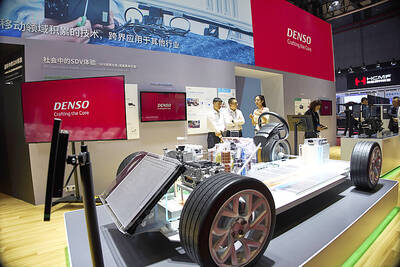LG Electronics Inc, the world’s No. 2 television maker, yesterday raised its LCD TV sales target for this year for Taiwan on the expectation that it would sell more 3D LCD TVs in this market.
LG Electronics Taiwan president Choi Bo-hwan said the company aimed to seize a 25 percent share of Taiwan’s LCD TV market this year, higher than the previous 20 percent target the company set earlier this year. The South Korean firm secured an approximate 15 percent share last year by shipments.
To reach the new goal, LG needs to sell at least 250,000 LCD TV units in Taiwan this year, as the overall LCD TV shipments are expected to grow by 10 percent this year from 1 million units last year based on LG’s projections.
About 20 percent of LG’s sales in Taiwan this year would be LCD TVs outfitted with 3D displays, Choi said.
“The Taiwanese market is similar to the South Korean market, as people [in both countries] tend to buy high-technology products,” Choi said. “And LG beat Samsung by taking a 67 percent share of South Korea’s 3D TV market after launching the new-generation 3D TVs earlier this year.”
Choi said the company would benefit from the uptake of 3D TVs this year. In South Korea, the penetration rate of 3D TVs has risen to 25 percent, compared with about 13 percent last year.
A significant drop in price of 3D glasses would be a key factor behind the takeoff of 3D TVs, Choi said.
The price of a pair of LG 3D glasses fell to just one-10th of last year’s price and the weight has been reduced to 16g per pair, he said, adding that no battery recharging would be needed as the company’s new technology allowed the glasses to operate without power consumption.
With an aggressive global sales target, LG was likely to increase purchases of TV panels, such as 65-inch panels — which LG Display does not produce — from Taiwanese LCD panel maker AU Optronics Corp (友達光電), a person familiar with the matter said.
“The procurement will be larger than three years ago, when LG bought a total of US$1 billion in LCD panels from Taiwanese firms,” said the source, who declined to be named.
Samsung, which also has ambitions in the 3D TV market, said last month it expected 30 or 40 percent of its LCD TVs sold this year would be 3D TVs.
However, Maxwell Chang (張乘維), an analyst with Topology Research Institute (拓墣產業研究所), was more conservative, citing high price tags as a potential obstacle for those TV brands to hit their business targets.
Chang expects a 10 percent penetration rate in Taiwan to be the best-case scenario. Globally, he projected about 20 percent of a total 215 million LCD TVs would be 3D TVs this year.

GROWING OWINGS: While Luxembourg and China swapped the top three spots, the US continued to be the largest exposure for Taiwan for the 41st consecutive quarter The US remained the largest debtor nation to Taiwan’s banking sector for the 41st consecutive quarter at the end of September, after local banks’ exposure to the US market rose more than 2 percent from three months earlier, the central bank said. Exposure to the US increased to US$198.896 billion, up US$4.026 billion, or 2.07 percent, from US$194.87 billion in the previous quarter, data released by the central bank showed on Friday. Of the increase, about US$1.4 billion came from banks’ investments in securitized products and interbank loans in the US, while another US$2.6 billion stemmed from trust assets, including mutual funds,

AI TALENT: No financial details were released about the deal, in which top Groq executives, including its CEO, would join Nvidia to help advance the technology Nvidia Corp has agreed to a licensing deal with artificial intelligence (AI) start-up Groq, furthering its investments in companies connected to the AI boom and gaining the right to add a new type of technology to its products. The world’s largest publicly traded company has paid for the right to use Groq’s technology and is to integrate its chip design into future products. Some of the start-up’s executives are leaving to join Nvidia to help with that effort, the companies said. Groq would continue as an independent company with a new chief executive, it said on Wednesday in a post on its Web

JOINT EFFORTS: MediaTek would partner with Denso to develop custom chips to support the car-part specialist company’s driver-assist systems in an expanding market MediaTek Inc (聯發科), the world’s largest mobile phone chip designer, yesterday said it is working closely with Japan’s Denso Corp to build a custom automotive system-on-chip (SoC) solution tailored for advanced driver-assistance systems and cockpit systems, adding another customer to its new application-specific IC (ASIC) business. This effort merges Denso’s automotive-grade safety expertise and deep vehicle integration with MediaTek’s technologies cultivated through the development of Media- Tek’s Dimensity AX, leveraging efficient, high-performance SoCs and artificial intelligence (AI) capabilities to offer a scalable, production-ready platform for next-generation driver assistance, the company said in a statement yesterday. “Through this collaboration, we are bringing two

Even as the US is embarked on a bitter rivalry with China over the deployment of artificial intelligence (AI), Chinese technology is quietly making inroads into the US market. Despite considerable geopolitical tensions, Chinese open-source AI models are winning over a growing number of programmers and companies in the US. These are different from the closed generative AI models that have become household names — ChatGPT-maker OpenAI or Google’s Gemini — whose inner workings are fiercely protected. In contrast, “open” models offered by many Chinese rivals, from Alibaba (阿里巴巴) to DeepSeek (深度求索), allow programmers to customize parts of the software to suit their